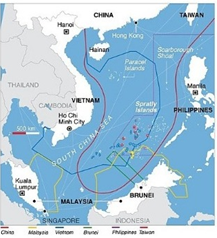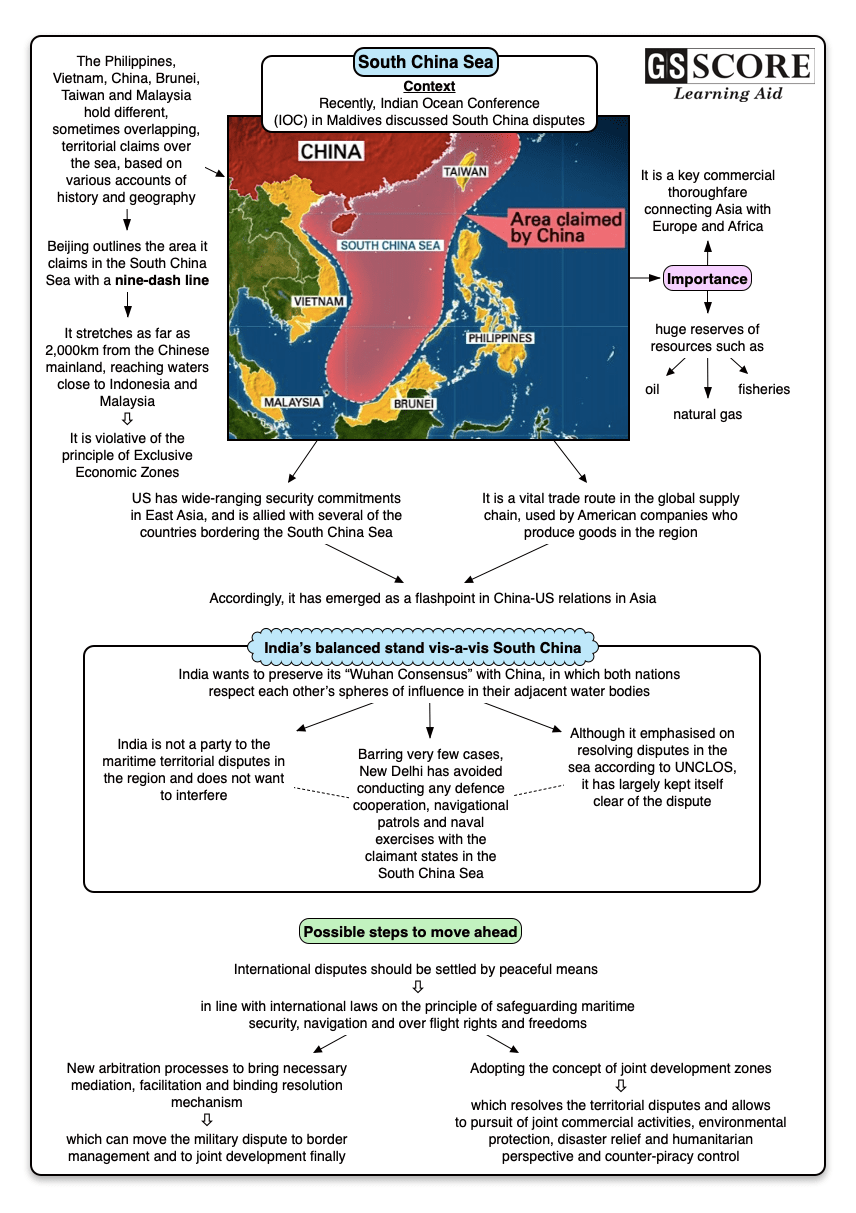

Recently, Indian Ocean Conference (IOC) in Maldives discussed South China disputes.
Issue
- Recently, Indian Ocean Conference (IOC) in Maldives discussed South China disputes.
Background
|
Geographic Facts
|
- The South China Sea, one of the world’s busiest waterways, is subject to several overlapping territorial disputes involving China, Vietnam, the Philippines, Taiwan, Malaysia and Brunei.
- The conflict has remained unresolved for decades but has emerged as a flashpoint in China-US relations in Asia.
- Beijing outlines the area it claims in the South China Sea with a nine-dash line, rather than a continuous border. Various other claimants have sought a clearer delineation of its claims from officials. Mainland China occupied the Paracel Islands following the battle of the Paracel Islands in 1974. In the Spratly Islands, it has occupied six features since 1988 and Mischief Reef since late 1994/early 1995.
- In 2018, the entry of an American destroyer into waters within 12 nautical miles of an island over which Beijing has claimed sovereignty is certain to draw international attention again to the rapid military build-up by the Chinese in the South China Sea
- At Indian Ocean Conference (IOC) in Maldives the US Ambassador to South Korea attacked China for illegally building artificial islands and militarising them in the South China Sea to which China responded by saying that it has indisputable sovereignty over the Nansha Islands (Spratly Islands) and the adjacent waters of the sea.
- Analysts say the likelihood of the sea becoming the main theatre of Sino-US tension as Washington galvanises allies and friendly countries to do more to challenge Beijing in the waters – in particular, by conducting FONOPs (Freedom of Navigation Operations).
Timeline
- 1994 – The Convention on the Law of the Sea went into effect. The United States called this treaty the “Law of the Sea Convention.”
- 1997 – Beijing shared the first rendering of its “Nine-dash Line” extending roughly 1,118 miles from Hainan Island to waters off equatorial Borneo under China’s historical claim of having it in the past.

- 2002 – ASEAN and China signed the Declaration on the Conduct of Parties in the South China Sea.
- 2009 – China issued two diplomatic notes that appear to claim a majority of the South China Sea.
- 2013 – The Philippines challenged China’s claims of historic rights and other actions in an arbitration case under the Law of the Sea Convention.
- 2014 - The deployment of a Chinese drilling rig in waters near the Paracel Islands led to several confrontations between Vietnamese and Chinese ships and provoked protests in Vietnam. Later Beijing started building military installations. China has also established a new city on one of the islands – Sansha on Woody Island – in turn leading to an increased Chinese tourism.
- 2016 – The Arbitration Tribunal ruled in favor of the Philippines and rejected China’s maritime claims that go beyond the entitlements set out in the Convention. However, Beijing rejected the ruling and described it has having “no binding force”.
Analysis
What is the conflict about?
- The Philippines, Vietnam, China, Brunei, Taiwan and Malaysia hold different, sometimes overlapping, territorial claims over the sea, based on various accounts of history and geography.
- China claims more than 80 per cent, while Vietnam claims sovereignty over the Paracel Islands and the Spratly Islands.
- The Philippines asserts ownership of the Spratly archipelago and the Scarborough Shoal, while Brunei and Malaysia have claimed sovereignty over southern parts of the sea and some of Spratly Islands.
- Over the years, the claimants have seized control of a raft of sea features, including rocks, islands and low-tide elevations.
- China‘s “nine-dash line” is a geographical marker used to assert its claim. It stretches as far as 2,000km from the Chinese mainland, reaching waters close to Indonesia and Malaysia. It is violative of the principle of Exclusive Economic Zones (EEZ)
- The stalled negotiations between China and ASEAN made headway on Code of Conduct as four of the ASEAN nations also made territorial claims on the disputed waters which adds to the problem with already non-negotiable behavior of China.
Why is it important?
- The South China Sea is a key commercial thoroughfare connecting Asia with Europe and Africa, and its seabed is rich with natural resources. One third of global shipping, or a total of US$3.37 trillion of international trade, passes through the South China Sea.
- About 80 per cent of China’s oil imports arrive via the Strait of Malacca, in Indonesia, and then sail across the South China Sea to reach China.
- The sea is also believed to contain major reserves of natural resources, such as natural gas and oil.
- The US Energy Information Administration estimates the area contains at least 11 billion barrels of oil and 190 trillion cubic feet of natural gas. Other estimates are as high as 22 billion barrels of oil and 290 trillion cubic feet of gas.
- The South China Sea also accounts for 10 per cent of the world’s fisheries, making it a key source of food for hundreds of millions of people.
What role does the US play in the dispute?
- The US has wide-ranging security commitments in East Asia, and is allied with several of the countries bordering the South China Sea, such as the Philippines, Singapore and Vietnam.
- Furthermore, the South China Sea is a vital trade route in the global supply chain, used by American companies who produce goods in the region.
- Although the US does not officially align with any of the claimants, it has conducted Freedom of Navigation operations, designed to challenge what Washington considers excessive claims and grant the free passage of commercial ships in its waters.
- During the summer of 2018, British and French forces conducted similar operations in the disputed waters.
Is there any resolution in sight?
- Southeast Asian nations have traditionally rejected looking for a bilateral solution with China, the region’s main economic and military power. Despite this, one year after the landmark ruling against China's territorial claims, Philippine President Rodrigo Duterte agreed to solve the dispute with China through bilateral talks.
- Similarly, Vietnam, the most outspoken critic of China, has softened its stance. In April 2018, the government said it would be willing to hold talks with China to resolve disputes in the area “in accordance with international law”.
- ASEAN has been working with China on an official code of conduct to avoid clashes in the disputed waters. A binding agreement has been discussed for years to little avail but in August 2018 it was revealed all the parties had agreed on a single draft negotiating text.
Challenges
- China’s behavior of negligence, denial and the sense of superiority while overlooking international laws and regulations like the UN Convention on the Law of the Sea.
- Along with China’s bullying tactics, North Korea’s provocative behaviour has attracted US aircrafts in the already troubled waters. The growth of military vessels and planes in the area makes it more challenging to handle.
- Undefined geographic scope of the South China Sea; disagreement over dispute settlement mechanisms; different approaches to conflict management (self-restraint, mutual trust, and confidence building); and the undefined legal status of the Code of Conduct (COC) add to it.
- The different histories of distant, largely uninhabited archipelagos of the sea make the matter more complicated and multifaceted.
Achievements
- The members of the Association of Southeast Asian Nations (ASEAN) and China engaged in discussions on a potential COC to manage the South China Sea maritime and territorial disputes for a very long time and finally settled for a non-binding Declaration on the Conduct of Parties in the South China Sea (DOC) in 2002. In 2005, the first draft of guidelines to implement the DOC was drawn up, but not adopted until 2011. However, problems still linger so a plan for more robust policies is needed.
- After the consultations of 2016, in 2017 ASEAN and China adopted a bare-bone framework for the COC.
Suggestions
- New arbitration processes to bring necessary mediation, facilitation and binding resolution mechanism which can move the military dispute to border management and to joint development finally.
- Adopting the concept of joint development zones, which resolves the territorial disputes and allows to pursuit of joint commercial activities, environmental protection, disaster relief and humanitarian perspective and counter-piracy control.
- International disputes should be settled by peaceful means in line with international laws on the principle of safeguarding maritime security, navigation and over flight rights and freedoms.
India’s Stand on South China Sea Issue
- In a Joint Strategic Vision for the Asia-Pacific and the Indian Ocean Region, India and the USA talked about ensuring freedom of navigation and resolving disputes according to UNCLOS referring to the South China Sea but after Philippines won the arbitration award in its favour in 2016, India has clearly separated itself from the dispute.
- New Delhi has not conducted any defence cooperation, navigational patrols and naval exercises with the claimant states in the South China Sea (only recently it conducted a naval exercise with Vietnam).
- After the recent development of affairs with Japan and Russia, it might appear that India wants to raise its strategic presence in the South China Sea but it is not so. Firstly, because India is not a party to the maritime territorial disputes in the region and does not want to interfere. Secondly, India wants to preserve its “Wuhan Consensus” with China, in which both nations respect each other’s spheres of influence in their adjacent water bodies.
Way Forward
- Forming an overarching authority like NATO or European Union (EU) with China as a member, in Asia to settle grievances and specifically find solutions to Asian problems, might help resolve disputes like this.
- The sense of power of China needs to be checked so that it abides by the intergovernmental and international agreements and conventions.
- Peaceful bilateral or multilateral talks and negotiations can be used because aggression or war is not a solution to this or any problem at all.
Learning Aid


